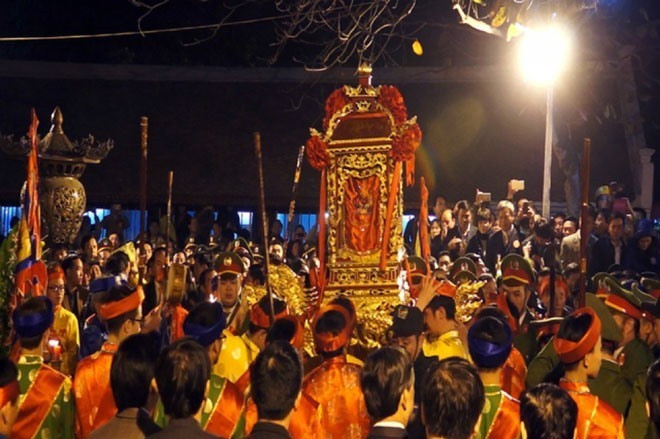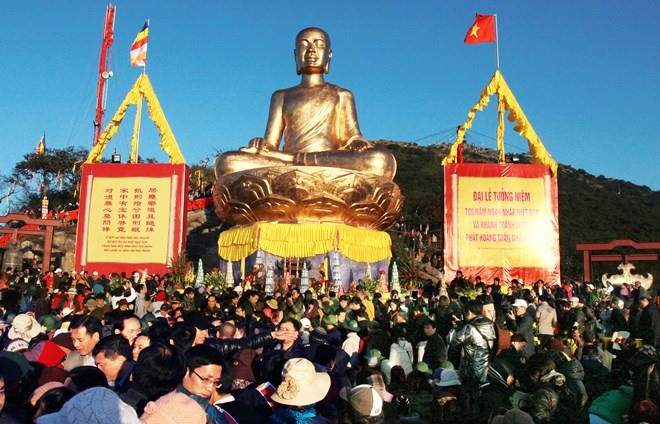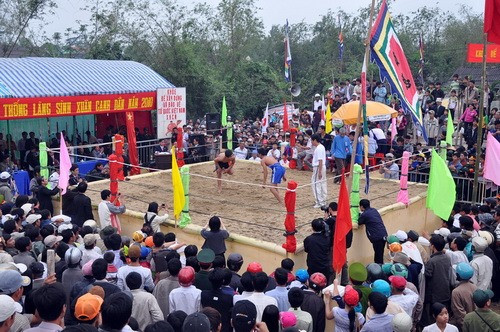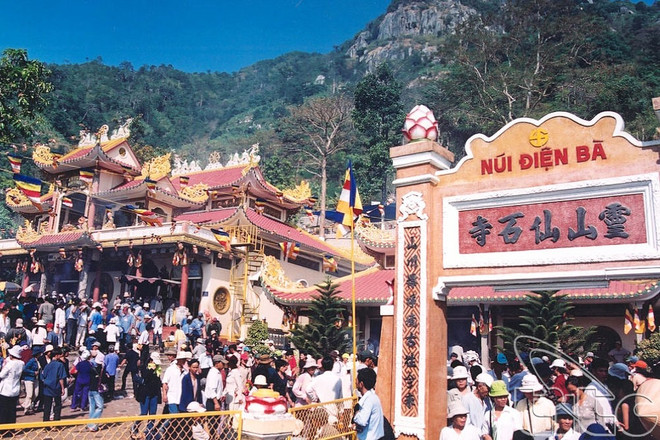 Taking a cruise along Yen Stream is a fantastic journey (Photo: Ministry of Culture, Sports and Tourism of Vietnam)
Taking a cruise along Yen Stream is a fantastic journey (Photo: Ministry of Culture, Sports and Tourism of Vietnam)Hanoi (VNA) - Going to festivals at the beginning of the year is a long-standing tradition of Vietnamese people. It is also a occasion for people to spend time with their families and friends while praying for luck and good things for the new year.
Huong Pagoda festival: A journey to the Buddhist land
The Huong (Perfume) Pagoda in My Duc district, Hanoi is well-known as not only a religious site, but also a great sight-seeing spot in the country. During its festival, the nation’s most elaborate one, which lasts from the beginning of January to the end of March in the lunar calendar, the pagoda attracts millions of pilgrims and visitors.
Hundreds of pagodas and shrines are scattered along the Yen Stream including Chua Ngoai (Outer Pagoda) and Chua Trong (Inner Pagoda). The centre of the complex is the Huong Pagoda proper deep inside Huong Tich Cave.
Tourists take a boat trip from Duc Dock to Outer Pagoda, which was also named Tro Pagoda.
Tran temple seal opening ceremony in Nam Dinh
The ceremony re-enacts a custom dating back to the Tran Dynasty (1225-1400), when mandarins took out their seals after the Lunar New Year holiday (Tet) to resume administrative activities, including conferring titles.
The ritual of opening the royal seal is an important ceremony held at the Tran Temple Festival in Nam Dinh province on the night of the 14th day of the first lunar month. The seal-opening ceremony dates from a time when the King worshiped the Heaven God and the royal court opened the national seal to return to normal work after a Lunar New Year holiday.
At midnight on the 14th day of the first lunar month, a senior man representing the village conducts the ceremony at Co Trach Temple, Tuc Mac village. A procession then carries the seal to Thien Truong Temple, where a prestigious member of the community stamps the seal on pieces of yellow paper which the attendees can bring home as a token of luck and happiness for the New Year. The seal-opening ceremony has been repeated for many years in Tuc Mac village.
The ritual is followed by a festival with weightlifting, dragon and tiger dances, and chess competition. Rituals at the Tran Temple and relic site honour a triumphant period in Vietnam’s history and encourage a spirit of patriotism.
 The Tran Temple Festival is annually organised from the 13th - 18th day of the first lunar month. (Photo: VNA)
The Tran Temple Festival is annually organised from the 13th - 18th day of the first lunar month. (Photo: VNA)Yen Tu Festival
The Yen Tu Festival, which is held at the Yen Tu historical relic and landscape area in the northern province of Quang Ninh from the tenth day of the Lunar New Year through the end of the third lunar month, is a major spring festival for Buddhists and tourists nationwide.
The event is held to review the great value of Yen Tu mountain, the origin of Truc Lam Buddhist Zen sect and the contribution of King-Monk Tran Nhan Tong. It features a procession from the foot of the mountain to Hue Quang Tower and Hoa Yen Pagoda and an incense offering ceremony to pray for the peace of the nation.
 The Yen Tu Spring Festival kicks off on the 10th day of the Lunar New Year (Photo: The Ministry of Culture, Sports and Tourism)
The Yen Tu Spring Festival kicks off on the 10th day of the Lunar New Year (Photo: The Ministry of Culture, Sports and Tourism)King Mai temple festival
The King Mai temple festival is held from 13th to 16th of the first lunar month of the year to commemorate the merits of King Mai Hac De (Mai Thuc Loan). There is also the review of the heroic and indomitable spirit of the Hoan Chau uprising against the domination of the Tang Dynasty, gaining independence for the nation for nearly 10 years from 713 to 722.
This is also an opportunity to educate patriotism, arouse national pride among people from all walks of life, and contribute to introducing and promoting the people and "sacred land with extraordinary people" of Nam Dan, the central province of Nghe An. This contributes to the economic, cultural and social development of the locality.
In addition to the variety of ceremonies, the festival features many traditional folk games interwoven with cultural and sports activities. These include drum performances, dragon - lion dances, camping, "chicken sticky rice" contest, flower lantern festival, Vi Giam folk song contest, wrestling festival, boat race, volleyball competition and card chess. These events draw thousands of participants.
Wrestling festival in Sinh village
The festival has been observed on the tenth day of the first lunar month every year for the past five centuries in Sinh village (now Lai An village) in the central province of Thua Thien-Hue.
It aims to pray for a New Year with favourable weather, peace and prosperity while promoting sporting movement in the community.
The wrestlers are divided in two age categories of under 15 years old and above 16 years old.
In the qualifying round, a wrestler has to beat their three rivals to enter the semi-final, in which he has to defeat another rival to advance to the final match. The wrestler who is lifted off the ground or falls on his back loses the game.
 The Sinh village wrestling festival generates excitement among crowds in Hue (Photo: The Ministry of Culture, Sports and Tourism)
The Sinh village wrestling festival generates excitement among crowds in Hue (Photo: The Ministry of Culture, Sports and Tourism)Ba Den Mountain Festival
 The Ba Đen Mountain Spring Festival is a favorite spiritual destination of locals and Buddhists in the spring. (Photo: Ministry of Culture, Sports and Tourism of Vietnam)
The Ba Đen Mountain Spring Festival is a favorite spiritual destination of locals and Buddhists in the spring. (Photo: Ministry of Culture, Sports and Tourism of Vietnam)The Spring Festival of Ba Den Mountain is an annual event which is organised during the first month of a lunar year. Even so, the main ceremonies are carried out on the 18th night and the 19th day of that month. This is a traditional festival of the communities residing in and near the Nui Ba complex.
On the days of the festival, the monks of highest ranks in Ba Den Temple carry out the Moc Duc Ceremony at midnight, when the amount of light in the main hall is lowest. As Moc Duc means “To bathe the Godess”, the monks use incense-imbued towels to wash the statue of the Black Virgin. The water used in this ceremony is made from lotus, jasmine, and cinnamon. The washing procedure is then carried out by young girls. Dressing in the most beautiful costumes like those of a princess, they dance in pairs and slowly walk into the hall while the ceremony music is being played in the background. After that, they carefully wash and change the costume of the statue. When everything is done, the monks worship the Goddess, asking for her protection and care before announcing the official beginning of the festival./.




























